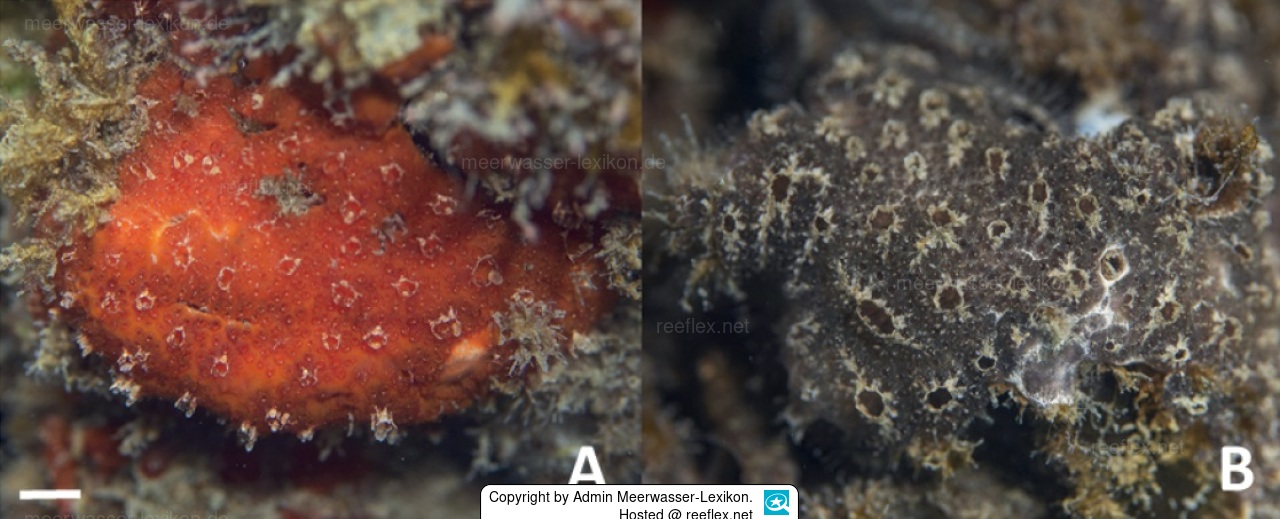Info
Distaplia stylifera is a colonial sea squirt that occurs in three color morphs, white, orange, and purple, and exhibits invasive behavior in the Gulf of California, Baja California.
Colonies may have a mushroom coral-shaped appearance, with many white speckles marking the common cloacal openings.
Colonies may also be cushion-shaped and spread over the substrate without a stalk.
Individual zooids reach up to 5 millimeters in height and divided into thorax and abdomen.
One pouch, smaller than the abdomen and connected to its right posterior side, contains the gonads.
The second pouch contains embryos and larvae in the incubation period and may be longer than the zooid itself, this pouch is connected by a thin stalk to the zooid at the posterior part of the pharynx on the right side near the dorsal line.
Sea squirts are very difficult to maintain in marine aquariums because they require a regular influx of plankton for feeding.
Synonyms:
Didemnium stylifera Kowalevsky, 1874
Didemnum stylifera Kowalevsky, 1874
Didemnum styliferum Kowalevsky, 1874
Distaplia bursata (Van Name, 1921)
Holozoa bursata Van Name, 1921
Literature reference:
Moreno-Dávila B, Huato-Soberanis L, Gómez-Gutiérrez J, Galván-Tirado C, Sánchez C, Alcoverro T, Balart EF, Turon X (2023)
Taxonomic identity of Distaplia stylifera (Tunicata, Ascidiacea), a new arrival to the eastern Pacific displaying invasive behavior in the Gulf of California, Mexico.
ZooKeys 1157: 109-125. https://doi.org/10.3897/zookeys.1157.95986
This is an open access article distributed under the terms of the Creative Commons Attribution License (CC BY 4.0), which permits unrestricted use, distribution, and reproduction in any medium, provided the original author and source are credited.
Colonies may have a mushroom coral-shaped appearance, with many white speckles marking the common cloacal openings.
Colonies may also be cushion-shaped and spread over the substrate without a stalk.
Individual zooids reach up to 5 millimeters in height and divided into thorax and abdomen.
One pouch, smaller than the abdomen and connected to its right posterior side, contains the gonads.
The second pouch contains embryos and larvae in the incubation period and may be longer than the zooid itself, this pouch is connected by a thin stalk to the zooid at the posterior part of the pharynx on the right side near the dorsal line.
Sea squirts are very difficult to maintain in marine aquariums because they require a regular influx of plankton for feeding.
Synonyms:
Didemnium stylifera Kowalevsky, 1874
Didemnum stylifera Kowalevsky, 1874
Didemnum styliferum Kowalevsky, 1874
Distaplia bursata (Van Name, 1921)
Holozoa bursata Van Name, 1921
Literature reference:
Moreno-Dávila B, Huato-Soberanis L, Gómez-Gutiérrez J, Galván-Tirado C, Sánchez C, Alcoverro T, Balart EF, Turon X (2023)
Taxonomic identity of Distaplia stylifera (Tunicata, Ascidiacea), a new arrival to the eastern Pacific displaying invasive behavior in the Gulf of California, Mexico.
ZooKeys 1157: 109-125. https://doi.org/10.3897/zookeys.1157.95986
This is an open access article distributed under the terms of the Creative Commons Attribution License (CC BY 4.0), which permits unrestricted use, distribution, and reproduction in any medium, provided the original author and source are credited.







 Admin Meerwasser-Lexikon
Admin Meerwasser-Lexikon








